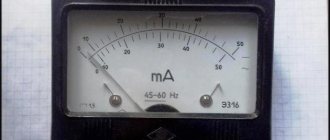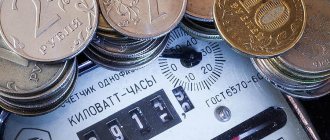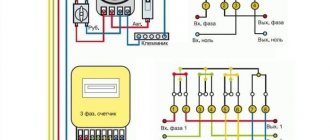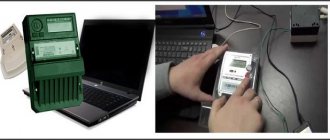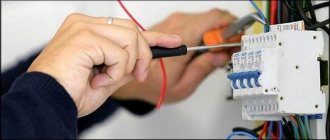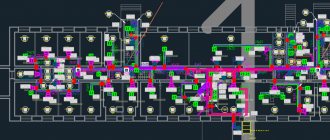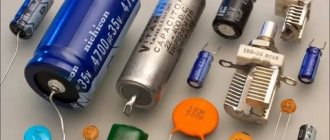The accuracy class of an electric meter is the main parameter of the device, which indicates the maximum possible error when measuring consumed electricity. For example, a device with an accuracy class of 1.0 has an error of plus/minus 1. The parameter is indicated in the passport of the electric meter and on its body in the form of a number inside a circle.
According to GOST 31818.11-2012 (IEC 62052-11:2003), electricity meters can be of the following classes: 0.2S; 0.2; 0.5S; 0.5; 1.0; 2.0.
For each class, errors are determined, which are influenced by various conditions:
| Characteristic | 0.2S | 0.5S | 1 | 2 |
| Nominal value % | 0,5 | 1,0 | 2,0 | 3,0 |
| Extreme air temperature -35/+55 | 0,82/0,6 | 2,05/1,5 | 2,87/2,1 | 6,15/4,5 |
| Voltage in the range 0.5…1.8 | 0,6 | 1,2 | 3,0 | 4,5 |
| Reverse phase order | 0,05 | 0,1 | 1,5 | 1,5 |
| Constant magnetic induction | 2,0 | 2,0 | 2,0 | 3,0 |
| Radio frequency field | 1,0 | 2,0 | 2,0 | 3,0 |
| Voltage unbalance | 0,5 | 1,0 | 2,0 | 4,0 |
Requirements for the accuracy class of electricity metering devices are enshrined in RF PP No. 442
The obligation of consumers of utility resources to equip their premises with individual metering devices is prescribed in several regulatory legal acts of the Russian Federation. For example, owners must install an IPU to comply with the requirements for the energy efficiency of an apartment building (Part 9 of Article 11 No. 261-FZ) and to determine the volume of individual consumption of utility resources (Clause 80 of RF PP No. 354).
No. 261-FZ and RF PP No. 354 also stipulate that apartment buildings, if technically possible, should be equipped with common building meters for utility resources (Part 7, Article 13 No. 261-FZ, clause 80 of RF PP No. 354). This requirement applies to the accounting of all utility resources, including electricity.
The requirements for what electric energy meters installed in apartment buildings should be are set out in RF PP No. 442. Thus, according to clause 138 of RF PP No. 442, metering devices with an accuracy class of at least 2.0 must be installed in the owners’ premises.
Moreover, before the entry into force of RF PP No. 442, communal meters installed in apartment buildings could also have an accuracy class of 2.0 and higher. But, in accordance with the requirements of clause 138 of RF PP No. 442, from June 12, 2012, ODPU of electricity must have class 1.0 and higher.
Can the management authority charge residents an additional fee for replacing the ODPU
11081719
Principle of operation
The consumer of electricity sees on an electronic or analog display the already summarized result, expressed in kilowatt/hours consumed, that is, the electrical power consumed over a period of time.
It cannot be measured directly, as is done with measuring voltage or current, since power is the product of force and voltage, and therefore the following actions can be performed:
- measure these two quantities separately and manually calculate the kilowatts.
- make parallel measurements with a device that automatically sums up the readings and relates them to a unit of time.
It is the latter principle that is implemented in electric meters. Inside, a circuit based on a current and voltage transformer is used, as in wattmeters, and the presence of a counting mechanism allows you to determine the consumption for a specific period.
Thus, the electric meter combines two measuring instruments and automatically makes the calculation. In digital devices, there is no need for bulky transformers, since analysis and calculation of consumption is carried out by intelligent technologies, and the user receives information in the most convenient form.
The accuracy classes of IPU and ODPU differ
The accuracy class of an electricity meter is the maximum error that may occur when measuring electrical energy consumption. The accuracy class is expressed as a percentage: at 1.0 it is ± 1%, at 2.0 – ± 2%. That is, at 1.0 the measurements will be more accurate than at an error of 2.0.
The accuracy class of the PU must be indicated in its passport, as well as on the front panel of the meter: usually this figure is indicated in a circle.
At the same time, as stated in clause 142 of RF PP No. 442, if the consumer had an IPU with an accuracy class below 2.0 (most often 2.5) installed before May 2012, then it can be used until its verification period expires. Then it must be replaced by installing a new metering device that meets the requirements of clause 138 of RF PP No. 442.
The same requirements apply to the ODPU of electricity: if, before the entry into force of RF PP No. 442, a general house meter with an accuracy class below 1.0 was put into operation in the house, then it needs to be replaced only if it fails or the verification period has expired.
In new houses, all installed metering devices must comply with the requirements of RF PP No. 442: IPU must have an accuracy class of 2.0 and higher, ODPU - at least 1.0.
How to commission and seal an individual meter
17175513
Induction electricity meters
One of the types of metering devices is induction electricity meters, which were widely used until recently and continue to function in old houses. Electricity consumption can be determined by a rotating disk protected by glass. The rate of its rotation changes depending on the energy consumption, and the results are displayed on a set of reels with printed numbers.
The design includes two working elements: a voltage coil to limit alternating current, creating a magnetic flux equal to the voltage, and a current coil, also designed to excite a magnetic flux commensurate with the strength of the current passing through it. The operating principle of this device is based on these design features.
During the double passage of both magnetic fluxes through the aluminum disk along a parabolic trajectory, forces arise that act on this disk and cause it to rotate. The obtained data is output to the above-mentioned drums through an axis connected to a gear and screw drive. Thus, the higher the voltage, the faster the magnetic fluxes and associated mechanical parts will move.
Induction electricity meters are considered very reliable and durable, do not depend on power surges and are considered relatively inexpensive. A serious drawback of such devices that determine flow rate can be considered too large an error in measurements, poor protection against theft of electricity and the size of the device. The electric meter itself consumes a large amount of energy during operation.
The authorities considered the differences in the accuracy classes of IPU and ODPU to be the reason for the increase in the volume of CDs on SOI
A group of management organizations did not agree with the requirements to install metering devices with different accuracy classes, that is, in measurement errors, in MKD. They filed an administrative claim with the Supreme Court of the Russian Federation demanding that clause 138 of the RF PP No. 442 be declared invalid.
The management organizations indicated that this paragraph contradicts Part 1 of Art. 1 of the Civil Code of the Russian Federation and Part 1 of Art. 1 Residential Complex of the Russian Federation. It also puts participants in relations to purchase and pay for actually consumed electricity in an unequal position. Therefore, the norms of clause 138 of the RF PP No. 442 violate the principles of equality of participants in civil legal relations and equality of participants in relations regulated by housing legislation in the ownership, use and disposal of residential premises.
The different operating mechanisms of IPU and ODPU lead to an increase in the difference between the readings of the general house meter and the readings of individual metering devices. The volume of resources consumed by the house for the purpose of maintaining common property significantly exceeds the standard and the costs of paying for it fall on the shoulders of the management company.
Due to the different errors of metering devices, the readings of which are taken into account when calculating electricity charges for citizens and for persons paying for the Kyrgyz Republic on SOI, a situation arises when payers are billed different amounts for the same amount of resource. All errors in metering devices are interpreted in favor of the residents of the house, which violates the principles of justice, integrity and equality.
Because of this, as the management organizations indicated in the lawsuit, they are forced to pay inflated amounts for electricity consumed to maintain the common property of owners in apartment buildings, which leads to a deterioration in their financial situation and an increase in the amount of debt to RSO.
Pros and cons of installing smart meters in an apartment building
243235
What electricity meters can be installed by law?
How can you check your electric meter yourself?
I. Turn off all electrical appliances in the apartment (lamps, household appliances, etc.) At this moment, the electric meter readings should remain constant.
II. Take meter readings. Turn on a 100 W (0.1 kW) light bulb for 1 hour. View new readings. Calculate the difference with the original count.
The actual electricity consumption (kWh) of a 100-watt lamp per hour should be 0.1 kWh
III. The value obtained from the meter should not differ by more than 4% (permissible error) from the calculated value (0.1 kilowatt-hour)
Simple rules for operating an electric meter: do not hit, do not pour water on it, do not break the seal, do not open it. Work with electrical wiring and electrical equipment must be carried out in compliance with safety regulations. Electricity at 220 volts is no joke.
After 16 years of operation, the device needs to be verified in Metrology, but if a new device is installed to replace the old one, then it is not required to be verified before installation.
The cost of an electrical project for an apartment. | replacement of the electric meter Chelyabinsk
Need good furniture? Check out our custom-made wardrobes on our website! | Look here to buy kraft paper in rolls. Control and measuring equipment.
Copyright © 2007-2018, KAKRAS.RU
Differentiation of PUs by class protects consumers from unnecessary energy costs
The Supreme Court of the Russian Federation, having analyzed the norms of the contested clause 138 of the RF PP No. 442, noted that the requirement to use metering devices of a certain accuracy class for metering electrical energy complies with the current legislation.
So, according to Part 1 of Art. 13 No. 261-FZ, consumed energy resources are subject to mandatory accounting using metering devices, and the requirements for their characteristics are determined in accordance with the legislation of the Russian Federation.
Measuring instruments of an approved type that have been verified and ensure compliance with established requirements are allowed for use, including mandatory metrological requirements for measurements, mandatory metrological and technical requirements for measuring instruments (Part 1, Article 9 No. 102-FZ).
In this case, the accuracy classes of metering devices are determined in accordance with technical regulations and other mandatory requirements established for the classification of measuring instruments.
The use of meters of accuracy classes 0.5, 1.0 and 2.0 to measure the volume of electricity consumed complies with the requirements of GOST 31819.11-2012 (IEC 62053-11:2003).
The owners of premises in an apartment building and the management unit are not parties to the same agreement concluded with the resource supply organization, and do not have the same legal status:
- premises owners enter into an energy supply agreement with RSO;
- The management company enters into an agreement with the RSO for the supply of resources for the maintenance of the common property of the owners in the apartment building.
At the entrance to the MKD, the metering device records a large volume of electricity: the total volume of individual consumption and CR on the SOI. The higher the volume of resource consumption, the higher the error value.
Therefore, the accuracy class of a common house metering device is higher than the requirements for such a characteristic of the IPU. Such differentiation is aimed at protecting the interests of citizens living in apartment buildings: they should not incur additional costs caused by greater errors in accounting for utility resources.
The Supreme Court of the Russian Federation came to the conclusion that clause 138 of the RF PP No. 442 does not violate the principles of equality of civil transactions and participants in relations regulated by housing legislation. The management organizations' claim was rejected.
How to determine
The class designation is applied by the manufacturer on the case or on a scale under the glass; in most cases, this is a number placed in a circle, but in older versions, there may be a star instead of a circle. If there are doubts that the device does not correspond to the information provided, then you should contact an organization engaged in conducting metrological verifications, where the value of the error will be determined in the laboratory.
Based on the results of the research, a protocol is drawn up with the readings of the standard and verified instruments entered there, as well as an expert’s conclusion.
On a note
The Supreme Court of the Russian Federation, in its decision in case No. AKPI 18-1304, indicated that the difference in measurement error between IPU and ODPU is caused by different amounts of electricity that these devices record. The higher the volume of the metering device, the greater the error, therefore, the higher the accuracy class of the metering device must be so that it records the actual volume of resource consumed.
Management organizations that note an increase in excess resource consumption for the maintenance of common property of owners in an apartment building should remember the factors influencing this indicator:
- non-transfer of IPU evidence by owners;
- faulty information control systems, including those whose operation was subject to unauthorized interference;
- theft of utility resources bypassing the IPU;
- inefficient use of resources in common areas (for example, the light in the entrance is on all day).
To combat these factors, the management authority, together with the RSO, must develop a strategy to eliminate them and involve the MKD Council, active owners and residents of the building in the work.
Electronic type meters
Compared to induction devices, electronic devices have higher accuracy classes and can keep records according to several tariff plans at once. The essence of the operation of these devices is to convert analog signals coming from an electric current sensor. They then become digital codes that reflect the amount of electricity consumed in the form of numeric symbols. These codes are decrypted by a microcontroller, and the received data is displayed on the display.
Due to their design features, electronic devices have many more advantages compared to induction meters:
- They have high-class accuracy.
- Capable of measuring all types of electric current and recording them at different rates, depending on the time of day.
- The results obtained are stored in the equipment’s memory and can be easily retrieved if necessary.
- It is possible to remotely retrieve data from the device’s memory.
- Any attempts of unauthorized entry and theft are recorded by the device.
- Thanks to their small dimensions, electronic meters easily fit into any panels.
Certain disadvantages of these devices are their increased response to voltage surges, some difficulties in repair and maintenance, and the high price of some models.
Price
Undoubtedly, the accuracy class affects the cost of the device, although for household consumers this does not significantly affect the cost. If there is a need to purchase laboratory equipment, then you will have to pay a larger amount than for a household meter, which is due to the use of more expensive elements and materials.
Other selection criteria
It is better to refrain from buying overly cheap devices of dubious manufacture. Even if they are reliable in operation, this does not mean that they have passed metrological certification and are in the unified register of measuring instruments.
You should pay attention to manufacturers with extensive experience, and these are all domestic suppliers without exception. The device passport must contain the stamp of the manufacturer and the stamp of the state verifier. The meter housing must be sealed.
Additional convenience doesn’t hurt either, for example, in devices with LCD screens, readings are visible much better than with a mechanical pointer.
